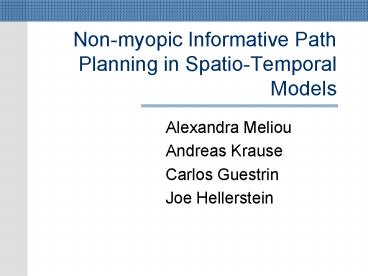Non-myopic Informative Path Planning in Spatio-Temporal Models - PowerPoint PPT Presentation
Title:
Non-myopic Informative Path Planning in Spatio-Temporal Models
Description:
Title: Non-myopic Informative Path Planning in Spatio-Temporal Models Author: EECS Dept. UC Berkeley Last modified by: EECS Dept. UC Berkeley Created Date – PowerPoint PPT presentation
Number of Views:207
Avg rating:3.0/5.0
Title: Non-myopic Informative Path Planning in Spatio-Temporal Models
1
Non-myopic Informative Path Planning in
Spatio-Temporal Models
- Alexandra Meliou
- Andreas Krause
- Carlos Guestrin
- Joe Hellerstein
2
Collection Tours
3
Approximate Queries
- Approximate representation of the world
- Discrete locations
- Lossy communication
- Noisy measurements
- Applications do not expect accurate values
(tolerance to noise) - Monitored phenomena usually demonstrate strong
correlations - Correlation makes approximation cheap
- Example
- Return the temperature at all locations 1C, with
95 confidence
4
Optimizing Information
Search for most informative paths
sensing nodes on path
Approximate answers
5
Continuous Queries
- Repeated at periodic intervals
- Finite horizon
- Example
- Return the temperature at all locations 1C, with
95 confidence, every 10 minutes for the next 5
hours.
6
Myopic vs Nonmyopic tradeoff
Myopic approach repeat optimization for every
timestep
Timestep 1
Timestep 2
7
Myopic vs Nonmyopic tradeoff
Nonmyopic approach optimize for all timesteps
No work!
Timestep 1
Timestep 2
Extra node
8
Quantify Informativeness
- Entropy
- Shewry Wynn 87
- Mutual Information
- Caselton Zidek 84
- Reduction of predictive variance
- Chaloner Verdinelli 95
9
Measuring Information
Observing 1 gives information on 3 and 4
Observing 2 gives information on 3 and 5
1
2
3
4
5
After observing 2, observing 3 becomes less useful
Diminishing Returns
10
Submodular Functions
X
More reward
X
Less reward
Entropy, mutual information and reduction of
predictive variance are all submodular.
11
Non-myopic Spatio-Temporal Path Planning (NSTP)
- Given
- A collection of submodular functions ft
- ft only depends on data collected at times 1..t
- A set of accuracy constraints kt
- Find
- A collection of paths Pt with
Minimize cost
Subject to reward constraints
12
Planning for multiple timesteps
obviously
- Harder than planning for one
- First idea
- Solve an equivalent single step problem instead!
13
Nonmyopic Planning Graph
t1
t2
t3
A solution path on the NPG collection of paths
for multiple timesteps
14
Solve the single step problem
- NP hard
- No good known approximation guarantees
- Dual Submodular Orienteering Problem
Maximize reward
Minimize cost
dual
primal
Subject to budget constraints
Subject to reward constraints
15
Good News
- The dual algorithm Chekuri Pal 05 provides
an O(logn) factor approximation
(where n is the size of the network)
16
Covering Algorithm
- Transform a dual blackbox solution to a primal
solution
dual
Call with BOPT
Return solution with reward K/a
(with a approximation factor)
primal
Reward required to cover
17
CoveringAlgorithm
- Transform a dual blackbox solution to a primal
solution
- Call SOP for increasing budgets
uncovered reward
- Call for budget 1
- Call for budget 2
- Call for budget BOPT
insufficient reward
reward sufficient!
- Guaranteed to cover K/a reward when called for
BOPT
- Update chosen set and repeat for uncovered reward
- Terminate when e portion left
Reward required to cover
Guaranteed to use at most budget
18
Bad News
- On the unrolled graph the Chekuri-Pal guarantee
becomes O(log(nT)) - The running time on the unrolled graph is
O((BnT)log(nT))
19
Addressing Computation Complexity
- DP Algorithm
- Algorithm details in proceedings
- Bug in proof of guarantees. Not fixed (yet)
- New algorithm Nonmyopic Greedy
- Details on my webpage
- Guaranteed to provide O(logn) approximation
Better than the previous O(log(nT))
20
Approach
- Replace expensive blackbox, with cheaper blackbox
More efficient Nonmyopic greedy calls the dual
on the smaller network graph instead of the
unrolled graph
Covering transformation
Blackbox for dual
Blackbox for dual
Nonmyopic greedy algorithm
Chekuri-Pal SOP on NPG
21
Nonmyopic Greedy
1. Condition on picked data 2. Recompute matrix
Time
Best ratio R/C
Return best of A1, A2
R 2 C 1
R 1 C 1
R 1 C 1
R 2 C 1
R 1 C 1
R 1 C 1
R 0 C 1
R 0 C 1
R 1 C 1
budget
dual(budget1,time3)
Budget
P3 Cost 1 Time 3
R 3 C 2
R 4 C 2
R 3 C 2
R 2 C 2
R 1 C 2
R 1 C 2
X
X
X
For border cases were A1 is bad, A2 is guaranteed
to be good
P2 Cost 1 Time 1
R 3 C 2
R 5 C 3
R 4 C 3
X
X
X
A1
dual(b,Gt)
P1 Cost 2 Time 2
A2
R 5 C 4
R 6 C 4
R 5 C 4
X
X
X
Best greedy choice condition on A1
dual(budget4,time1)
22
Nonmyopic Greedy Guarantees
Nonmyopic greedy Chekuri-Pal on NPG
O(B2T(nB)logn) O((nBT)log(nT))
running time
approximation
23
Myopic and Nonmyopic evaluation
- Setup
- 46 nodes on the Intel Berkeley Lab deployment
- 7 days of data (5 for learning, 2 for testing)
Varying Constraints
24
Cost and Runtime
Varying Horizon
25
Effect of greedy parameters
Varying budget levels
26
Conclusions
- Transform any blackbox solution to nonmyopic
- Obtain primal from dual
- Nonmyopic greedy provides significant runtime
improvements and better theoretical guarantees































